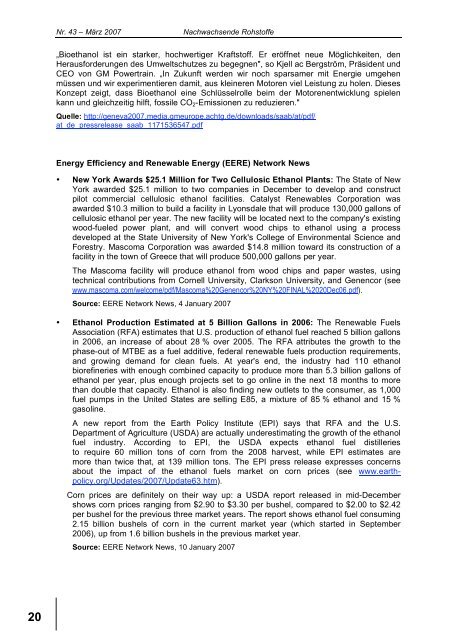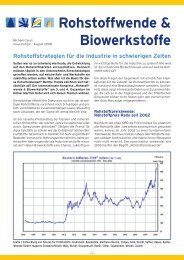Nachwachsende Rohstoffe - nova-Institut GmbH
Nachwachsende Rohstoffe - nova-Institut GmbH
Nachwachsende Rohstoffe - nova-Institut GmbH
Erfolgreiche ePaper selbst erstellen
Machen Sie aus Ihren PDF Publikationen ein blätterbares Flipbook mit unserer einzigartigen Google optimierten e-Paper Software.
20<br />
Nr. 43 – März 2007 <strong>Nachwachsende</strong> <strong>Rohstoffe</strong><br />
„Bioethanol ist ein starker, hochwertiger Kraftstoff. Er eröffnet neue Möglichkeiten, den<br />
Herausforderungen des Umweltschutzes zu begegnen", so Kjell ac Bergström, Präsident und<br />
CEO von GM Powertrain. „In Zukunft werden wir noch sparsamer mit Energie umgehen<br />
müssen und wir experimentieren damit, aus kleineren Motoren viel Leistung zu holen. Dieses<br />
Konzept zeigt, dass Bioethanol eine Schlüsselrolle beim der Motorenentwicklung spielen<br />
kann und gleichzeitig hilft, fossile CO2-Emissionen zu reduzieren."<br />
Quelle: http://geneva2007.media.gmeurope.achtg.de/downloads/saab/at/pdf/<br />
at_de_pressrelease_saab_1171536547.pdf<br />
Energy Efficiency and Renewable Energy (EERE) Network News<br />
• New York Awards $25.1 Million for Two Cellulosic Ethanol Plants: The State of New<br />
York awarded $25.1 million to two companies in December to develop and construct<br />
pilot commercial cellulosic ethanol facilities. Catalyst Renewables Corporation was<br />
awarded $10.3 million to build a facility in Lyonsdale that will produce 130,000 gallons of<br />
cellulosic ethanol per year. The new facility will be located next to the company's existing<br />
wood-fueled power plant, and will convert wood chips to ethanol using a process<br />
developed at the State University of New York's College of Environmental Science and<br />
Forestry. Mascoma Corporation was awarded $14.8 million toward its construction of a<br />
facility in the town of Greece that will produce 500,000 gallons per year.<br />
The Mascoma facility will produce ethanol from wood chips and paper wastes, using<br />
technical contributions from Cornell University, Clarkson University, and Genencor (see<br />
www.mascoma.com/welcome/pdf/Mascoma%20Genencor%20NY%20FINAL%2020Dec06.pdf).<br />
Source: EERE Network News, 4 January 2007<br />
• Ethanol Production Estimated at 5 Billion Gallons in 2006: The Renewable Fuels<br />
Association (RFA) estimates that U.S. production of ethanol fuel reached 5 billion gallons<br />
in 2006, an increase of about 28 % over 2005. The RFA attributes the growth to the<br />
phase-out of MTBE as a fuel additive, federal renewable fuels production requirements,<br />
and growing demand for clean fuels. At year's end, the industry had 110 ethanol<br />
biorefineries with enough combined capacity to produce more than 5.3 billion gallons of<br />
ethanol per year, plus enough projects set to go online in the next 18 months to more<br />
than double that capacity. Ethanol is also finding new outlets to the consumer, as 1,000<br />
fuel pumps in the United States are selling E85, a mixture of 85 % ethanol and 15 %<br />
gasoline.<br />
A new report from the Earth Policy <strong>Institut</strong>e (EPI) says that RFA and the U.S.<br />
Department of Agriculture (USDA) are actually underestimating the growth of the ethanol<br />
fuel industry. According to EPI, the USDA expects ethanol fuel distilleries<br />
to require 60 million tons of corn from the 2008 harvest, while EPI estimates are<br />
more than twice that, at 139 million tons. The EPI press release expresses concerns<br />
about the impact of the ethanol fuels market on corn prices (see www.earthpolicy.org/Updates/2007/Update63.htm).<br />
Corn prices are definitely on their way up: a USDA report released in mid-December<br />
shows corn prices ranging from $2.90 to $3.30 per bushel, compared to $2.00 to $2.42<br />
per bushel for the previous three market years. The report shows ethanol fuel consuming<br />
2.15 billion bushels of corn in the current market year (which started in September<br />
2006), up from 1.6 billion bushels in the previous market year.<br />
Source: EERE Network News, 10 January 2007
















